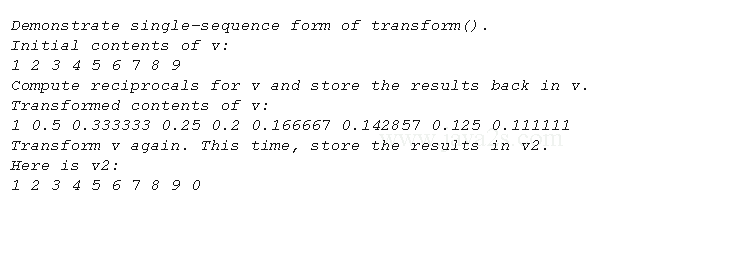Demonstrate the single-sequence form of transform(). - C++ STL Algorithm
C++ examples for STL Algorithm:transform
Description
Demonstrate the single-sequence form of transform().
Demo Code
#include <iostream> #include <vector> #include <algorithm> using namespace std; double reciprocal(double val); int midpoint(int a, int b); template<class T> void show(const char *msg, vector<T> vect); int main()// w w w . ja va 2 s . c om { int i; // First, demonstrate the single-sequence form of transform(). vector<double> v; // Put values into v. for (i = 1; i < 10; ++i) v.push_back((double)i); cout << "Demonstrate single-sequence form of transform().\n"; show("Initial contents of v:\n", v); cout << endl; // Transform v by applying the reciprocal() function. // Put the result back into v. cout << "Compute reciprocals for v and store the results back in v.\n"; transform(v.begin(), v.end(), v.begin(), reciprocal); show("Transformed contents of v:\n", v); // Transform v a second time, putting the result into a new sequence. cout << "Transform v again. This time, store the results in v2.\n"; vector<double> v2(10); transform(v.begin(), v.end(), v2.begin(), reciprocal); show("Here is v2:\n", v2); cout << endl; } template<class T> void show(const char *msg, vector<T> vect) { cout << msg; for (unsigned i = 0; i < vect.size(); ++i) cout << vect[i] << " "; cout << "\n"; } // Return the whole-number midpoint between two values. int midpoint(int a, int b) { return((a - b) / 2) + b; } // Return the reciprocal of a double. double reciprocal(double val) { if (val == 0.0) return 0.0; return 1.0 / val; // return reciprocal }
Result

Related Tutorials
- Calculate cube of each element in a sequence and place results in another sequence with algorithm transform.
- Using transform() to change array of inches values to cm
- Demonstrate the two-sequence form of transform()
- Using function objects with transform()
- Using transform() algorithm to negate and multiply function objects.